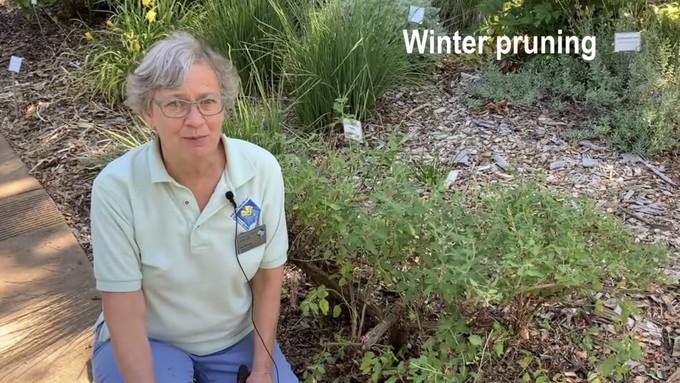
Topics include salvias, blueberries, grasses and more

Sacramento County master gardener Pat Schink explains winter pruning of woody sages, aka salvias, in a video available on YouTube. Screen grab from "Pruning Woody Sages," UCCE Master Gardeners of Sacramento County
No need to look far for great gardening advice: The Sacramento County group of master gardeners, not to mention other counties in California, have produced terrific -- and short -- videos on all kinds of topics.
This time of year the A-Number One topic is pruning, of course. Trees, roses, perennials, berry bushes all are dormant and can be pruned.
But pruning a plant you've invested time and money in can be scary to some people. What if it's ruined forever? They fret and then don't do anything. But ignoring pruning may ultimately hurt more than help that plant.
Below are suggestions on videos to watch that will explain the pruning process succinctly. But first, a few plants that should NOT be pruned during winter:
-- Apricot and cherry trees. Pruning cuts on these trees are susceptible infection from a fungus (Eutypa) and bacterial canker diseases that flourish in wet weather. Save those pruning duties for late summer.
-- Citrus trees. Pruning stimulates growth, and new growth is highly susceptible to frost damage. Wait until after harvest (usually April or May, depending on the type).
-- Lilacs, camellias and other spring-flowering shrubs. Easy reason: The risk of cutting off all those flower buds!
Here are my favorite master gardener pruning videos:
-- "Pruning Mature Blueberry Plants." Blueberries are fun to grow, but they can be mysterious to care for. Master gardener Tamara Engel demonstrates the best tools and techniques for thinning the plants before spring growth begins.
-- "Pruning Rosemary." Master gardener Karen Martin explains when and how to cut to keep this popular landscape herb looking great. A "hard pruning" to reshape the plant is recommended annually, usually in early spring, but any dead stems can be removed now. (Hint: Look near ground level for these.)
-- "Pruning Woody Sages." You know those wild-haired salvia plants? This is for them. They do so much better in the summer after a hard pruning in winter. Master gardener Pat Schink covers both growing-season pruning and dormant-season pruning, so bookmark this one for reference later in the year, too.
-- "Pruning Ornamental Grasses." This is a job for the February garden. Pat Schink explains the process for keeping these low-maintenance plants looking their best.
-- "How to Prune a Hybrid Tea Rose." Yolo County master gardener Marcia Nelson covers the basics in just 6 minutes. I also like Sacramento master rosarian Charlotte Owendyk's video, "How to Quickly Prune Roses," filmed for Green Acres and the Sierra Foothills Rose Society.
-- Of course, clean and sharp pruning tools are important to the process. "Sharpening Hand Pruners" is a must-see master gardener video, whatever type of plant will be pruned.
-- Winter pruning of fruit trees. For trees other than apricots and cherries, this is the time to shape deciduous fruit trees. Santa Clara County master gardener Allen Buchinski, in 2021 filmed a long presentation, "Pruning Fruit Trees," that covers many details. The county used to be known for its orchards, and this master gardener group has several fruit tree videos on its YouTube channel.
For more growing info from the UCCE master gardeners of Sacramento County: https://sacmg.ucanr.edu/
Comments
0 comments have been posted.Sacramento Digs Gardening to your inbox.
Sites We Like
Garden Checklist for week of May 12
Get your gardening chores and irrigation done early in the day before temperatures rise.
* Plant, plant, plant! It’s prime planting season in the Sacramento area. Time to set out those tomato transplants along with peppers and eggplants. Pinch off any flowers on new transplants to make them concentrate on establishing roots instead of setting premature fruit.
* Direct-seed melons, cucumbers, summer squash, corn, radishes, pumpkins and annual herbs such as basil.
* Harvest cabbage, lettuce, peas and green onions. This heat will cause leafy greens and onions to flower; pick them before they bolt.
* In the flower garden, direct-seed sunflowers, cosmos, salvia, zinnias, marigolds, celosia and asters.
* Plant dahlia tubers. Other perennials to set out include verbena, coreopsis, coneflower and astilbe.
* Transplant petunias, marigolds and perennial flowers such as astilbe, columbine, coneflowers, coreopsis, dahlias, rudbeckia and verbena.
* Keep an eye out for slugs, snails, earwigs and aphids that want to dine on tender new growth.
* Feed summer bloomers with a balanced fertilizer.
* For continued bloom, cut off spent flowers on roses as well as other flowering plants.
* Got fruit trees? If you haven't already done so, thin orchard fruit such as apples, peaches, pears, pluots and plums before they grow too heavy, breaking branches or even splitting the tree. Leave the largest fruit on the branch, culling the smaller ones, and allow for 5 to 6 inches (or a hand's worth) between each fruit.
* Thin grape bunches, again leaving about 6 inches between them. For the remaining bunches, prune off the "tail" end, about the bottom third of the bunch, so that the plant's energy is concentrated in the fruit closest to the branch.
* As spring-flowering shrubs finish blooming, give them a little pruning to shape them, removing old and dead wood. Lightly trim azaleas, fuchsias and marguerites for bushier plants.
* Add mulch to the garden to help keep that precious water from evaporating. Mulch also cuts down on weeds. But don’t let it mound around the stems or trunks of trees or shrubs. Leave about a 6-inch to 1-foot circle to avoid crown rot or other problems.